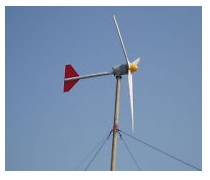Residential Wind Generators
Having your own residential wind generators may be the only way to keep ‘wired’ in the face of a disaster. If you experience a complete economic and social breakdown it may not be possible to rely on your city or town’s power grid, and living off the grid with wind generators may be your only option.

Before You Buy
Before you start writing checks there are some things you need to consider. Buying residential wind generators are a big step and can cost thousands of dollars. Do your due diligence first, buy second.
- The Amount of Energy Needed - The first thing to consider is how much energy you need. For things like charging batteries you can do with a small portable generator and they will work in most any place. For more energy needs, larger wind turbines are necessary and the location is vital. Classes are used to measure the amount and power of wind produced in an area.
- The Amount of Wind Needed - Next you will need to see if your area produces an efficient amount of wind. Different wind power turbines require different minimum classes. Most areas with a class of 1 are usually enough for most applications. To check your area check the US Department of Energy’s Wind Map.
- The Law - Once you have confirmed your area has sufficient wind you will need to check the local laws about having wind generators. Residential wind generators require being placed above most buildings which means they stand out. Some housing associations and cities have rules regarding this that need to be checked. You will also have to check with your local utility company for their rules regarding using wind power as extra energy. In some areas you can actually buy energy that is produced by wind rather than buying your own generator.
Get the Facts
There are a number of types of residential wind generators available today and it’s important to educate yourself before you go out and purchase one.
- Types- Residential wind turbines are usually like the traditional windmills that were once common many years ago. Vertical turbines are also available in the residential market. They have 2 or more blades which can be curved or straight. Smaller turbines can be mounted on rooftops but most need to be placed on the ground.
- Height- The higher the turbine, the more electricity it generates because it is up where the wind is more prevalent. The American Wind Energy Association states that smaller turbines are not cost effective unless wind speeds in your area are at least class 2, or 10 mph, at 33 feet above ground level. The Oregon Department of Energy notes that wind turbines should be at least 30 feet higher than any obstructions within a 300-foot radius.
- Generation Capacity- According to the AWEA, residential wind turbines usually have a generation capacity of 400 watts to 100 kilowatts. Wind generators placed in remote areas with fewer neighbors, less obstacles and higher wind speeds can be rated much higher.
- Permits- Municipalities, counties, townships, and states have their own regulations regarding residential turbines. In an unincorporated area, check with your county or township land-use office. In an incorporated area check with your town or city land-use office. Noise or height regulations may restrict or prohibit use of residential generators.
Top 2 Wind Generators
1. Southwest Windpower Skystream 3.7; this is the first fully integrated grid tied wind system for residential use. This “plug and play” turbine is designed to provide quiet clean electricity in very low winds. Its estimated energy production is 400 kWh/month @ 12 MPH. You can plug it in or use a battery. Price comes in at $5399 (not including tower and installation materials).
2. Southwest Windpower Air X; this is the world’s number one selling small wind turbine. The Air X uses new microprocessor-based technology that gives you increased performance, improved battery charging capacity, greater reliability, and reduces the flutter noise from the machine. This is great for powering small appliances in off grid installations, remote communications facilities, and marine applications. The cost, about $600.
Careful Planning
Don’t wait until disaster strikes and knocks down the traditional power grid before you run out and buy any residential wind generators. They can be expensive initially and take some planning to make sure you are in an area that makes sense to use one. You have to have a certain amount of wind available and you need to make sure you are in compliance with your cities, counties, townships laws and regulations.
Return from Residential Wind Generators to Survival Equipment





New! Comments
Have your say about what you just read! Leave me a comment in the box below.